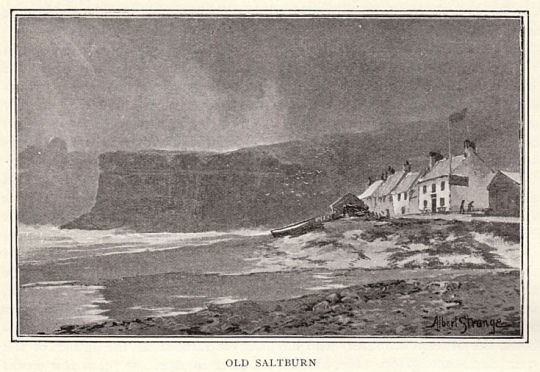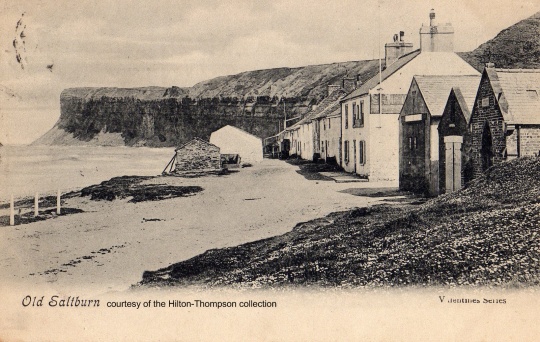Discovering Saltburn's rich heritage ...Old Saltburn.
There are two Saltburns; the Victorian planned new town and the ancient hamlet now known as Old Saltburn. The older of the two nestles below the cliffs under the shadow of Huntcliff. It has obscure origins, attracting only passing references in local histories and public documents, existing only to serve its few inhabitants making a living from such diverse occupations as farming, fishing, milling, lime burning and the export of alum, ironstone nodules and hazel rods. Its most exciting and lucrative activity was undoubtedly smuggling, led by the notorious John Andrew and the local gentry.

The history of Saltburn and the surrounding district dates back much further than documentary evidence can confirm. The discovery of a stone axe head on Saltburn Sands suggests that a settlement may have existed in the area since the Neolithic period. Other evidence of early settlements around the Saltburn area include the discovery of at least 3 cremation vessels and a Bronze Age burial mound at Cat Nab and an Iron Age grinding stone or quern on Huntcliff. All of this evidence supports the theory that settlements have existed in what is now old Saltburn, for much of Britain's early history
The name Saltburn first appears following the Anglo-Saxon invasion and is derived from the Saxon name for the local stream, Sealt-Burna, or salty stream. 300 years later the invading Vikings changed the name of the stream to the Skelton Beck, but the name of the settlement remained, giving its name to the modern town of Saltburn-by-the-Sea.
Saltburn's history continues throughout the medieval period with medieval field systems being discovered just outside of modern Saltburn, a shepherd's house between modern Saltburn and Brotton, examples of late medieval pottery and documentary remains of a small hermitage just east of Skelton Beck.

In 1615 an alum works was opened at Selby Hagg, just over a mile inland from the coast, and ships were beached at Saltburn both to unload the urine necessary for the manufacturing process and to load the finished product for the shipment to the crown's London warehouse. By 1670 there were two alum mines actually sited at Saltburn. They remained open until 1720. A brief revival occurred in 1765 but only lasted for 11 years.
The hamlet of Saltburn grew beneath Huntcliff and the prominent Cat Nab. It's origins can be dated back to the late 18th Century when the settlement of Old Saltburn consisted of a number of small cottages, two inns - the 'Ship' and the 'Nimrod' - and several gin shops. This small village, along with other coastal towns such as Staithes and Marske became a safe haven for smugglers during the late 18th and early 19th Centuries. Smuggling was an accepted way of life among the local people, with many of the smugglers being accepted among the local elite and often serving in the corrupt local law enforcement organisations. Saltburn was given its own detachment of coastguards housed in a row of purpose built cottages still seen on Huntcliff. Even after the heyday of smuggling had passed, the village of Old Saltburn remained a seafaring community,with most of the residents earning a living as sailors and fishermen. Some of the men were occupied seasonally in the collection of ironstone nodules from the beach for shipping to Newcastle although steady employment in this field was not secured until the first ironstone mine opened in 1864 at Hob Hill. The hamlet's nautical tradition is reflected in the building of a small mortuary in the 1880s in order to house the bodies of sailors frequently washed up on the beach.

| Descriptions of old Saltburn by writers and travellers 1808 - 1872 | ||
|---|---|---|
| Toggle table content | ||
|
Saltburn, a small hamlet within this chapelry, (Brotton) stands about two miles to the north-west,
and consists of a few houses scattered irregularly upon the sea-shore, inhabited chiefly by fishermen. Rev.John Graves 'The History of Cleveland' pub 1808. |
||
|
A small village (if it may be called)about five miles and a half east of Redcar and three miles eastward of
Marske, consists of a few houses at the foot of Huntcliffe rocks, the best road to which is on the sands.
Here is a small but clean Inn to which many of the visitors at Redcar resort, where, after their ride or walk,
they may enjoy a treat of tea and 'fat rascals', and those who visit Saltburn for pleasures of a different
description - such as beautifully romantic scenery and magnificently extensive sea views - will find
themselves amply repaid if they ascend to the top of the cliffs. W Harrison of Ripon, 1841. |
||
| Saltburn is a small hamlet, containing about sixteen houses, situated on the sea and under a
mountain. I remarked to the inhabitants that if they could keep peace with themselves they would keep
peace with all the world, for nobody would come to quarrel with them. Nor could a more abstracted spot
be found, if man chose to hide himself from man. It is shut out from the world into a nook or corner
of creation, with lofty hills screening it from the south, and almost swallowed up by the sea on the north,
which, in the winter, dashes up to the doors of the houses. Eastwards the massive overhanging cliffs of
Huntcliff tower proudly into the heavens, assuming a most sublime and terrible aspect when wrestling
with the sea. John Walker Ord 'The History and Antiquities of Cleveland' pub 1846 |
||
| All visitors to Saltburn should, in observance of laudable and prescriptive usuage, make a point of duty,
once at least, to drink tea and eat 'Fat Rascalls.' (Small, round, very rich cakes made of flour, butter
and currents, served hot) Walbran writing in the first guidebook to Saltburn ever published, 1848 |
||
| The path zig-zags steeply, and would be dangerous in places were it not protected by a handrope and posts. At the public house below the requirements of a simple dinner can be had, and excellent beer. While I ate, two men were busy casting bullets, and turning them out to cool in the middle of the floor. They were going to shoot cormorants along Huntcliff Nab, where the birds lodge in the clefts. Concerning the Nab, an ancient
writer describes it as 'full of craggs and steepe rocks, wherein meawes, pidgeons and sea-fowle breade plentifully.' And seals resort to the rocks about its base, cunning animals, which set a sentry for the approach of men, and dive immediately the alarm is given. But the 'poore women that gather cockles and mussels on the sandes, by often use are in better credyte with them. Therefore, whoso intends to kill any of them must craftely put on the habyte of a woman, to gayne grounde within the reach of his peece'. Walter White 'A Months Tour of Yorkshire' 2nd edition pub 1858 |
||
| My friend (John Walker Ord) would not now merely find some remnants of the old sea-side smuggling hamlet of the past - busy enough in the days of Will Watch, the brave smuggler, that famed and lawless fellow, once feared, now forgot, and such like rude opponents of impolitic Excise Laws, but quiet then as a 'dove's nest,' to which he had so aptly compared its situation. Were he now (1872) to raise his eyes to what then was simply a sea cliff, inhabited only by sheep that grazed along its summit, and the seagulls, he would see fair and lofty houses, hotels, church, chapels, school, railway station and all the latest appliances of modern civilisation.' George Markham Tweddell 'History of Cleveland' (unfinished) 1872 |
||
The Ship Inn
At one time the hamlet of Saltburn is said to have sported four inns - The Seagull, the Dolphin, the Nimrod (sited where the Mortuary now stands) and The Ship. The Ship, which dates back to some time in the late 1500s, survives today, having been enlarged over the centuries with the original bar closest to the road. The Inn itself was at the centre of the smuggling trade with its most famous landlord being John Andrew, known locally as the 'King of Smugglers'. Improvements to the Ship came slowly. Although electricity for private comsumption came to Saltburn in 1900, hurricane styled lamps were still being used in the Inn as late as World War II.
The original Saltburn, consisting now of a single row of what were once fishermen's cottages and the Ship Inn, still stands entirely alone, facing the sea on the Huntcliff side of Skelton beck.
Research by Rebecca Hilton. Collecting primary source materials, articles and extracts from books related to the development of both Saltburn's and trying to validate them has offered conflicting information, much of which is often difficult to validate as many sources can prove to be unreliable e.g. newspapers or census data. Every effort has been made to ensure that the information on the history of the town presented here is as accurate as possible.
